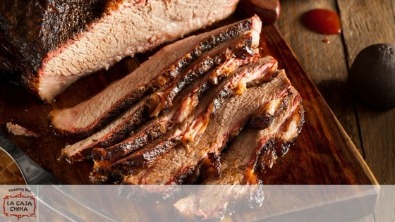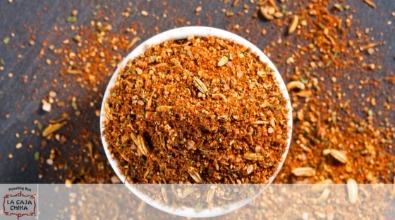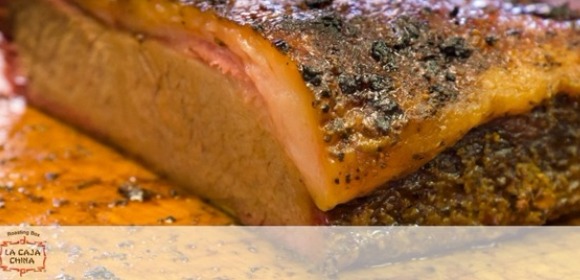Texas Brisket on La Caja China
Recipe by Dorothy Randoll
(Dorothy Randoll is a Dallas-area writer and special contributor to The Dallas Morning News. She appeared with chef Tyler Florence on the Texas Ranch Roast episode of Food 911 on the Food Network.) Beefy, moist, falling-apart tender brisket is what you"ll have with these easy instructions for preparing one 15-pound brisket on La Cajita China. The same process works with La Caja China and as many as six briskets.

What you need:
La Caja China or La Cajita China
CharcoalHeavy-duty aluminum foil
Oven mitts (the new silicon ones are particularly handy)
A rimmed baking pan that will fit inside La Cajita
Instant-read thermometer
Brisket
Dry Rub
Basting sauce
Basting brush
Barbecue sauce
Everything can be ready ahead of time: mix the dry rub and make the basting sauce days ahead of time; have the charcoal and heavy-duty aluminum foil on hand.
Brisket: Buy an untrimmed (sometimes called packer style) brisket available at most grocery stores. It will have a thick cap of fat and is usually in heavy plastic packaging. In Texas, it's frequently on sale during the summer for 99 cents a pound. We stock up for barbecuing all winter long. A 15-pound brisket fits nicely on La Cajita China; briskets are available in size from about 8 pounds and up. Calculate about 2 servings per pound. Leftovers reheat and freeze well, so don't underestimate quantity. Besides, you probably won't have much left over to worry about! La Caja China can accommodate about 6 briskets, depending on their size.

Dry rub: Tyler Florence's Ancho Chile Rub is excellent on brisket. You may already have a personal "house blend" combination of seasonings that you like. For those who prefer less spice, try this:
1/2 cup kosher salt
2 tablespoons freshly ground black pepper
2 tablespoons garlic powder
1 tablespoon onion powder
Stir together to blend; store indefinitely
Optional additions, to suit your taste:
1 tablespoon seasoned salt (such as Lawry's)
Chili powder to taste
Cumin to taste


Basting Sauce: You'll only baste the brisket once in this process. Basting adds moisture and flavor. You'll need about 3/4 cup. You can use apple juice or a 50 / 50 blend of cider vinegar and water. I prefer to use this thin, tangy-sweet barbecue sauce for basting brisket; it's also good with pork and chicken. Don't use a thick, heavy sauce as it may burn.
Dorothy's Barbecue Sauce
1/2 cup bottled barbecue sauce
1/2 cup catsup
1/2 cup cider vinegar
1/4 cup lemon juice
1/2 cup Worcestershire sauce
1 cup water
1 tablespoon salt
1 tablespoon chili powder -- optional
1 tablespoon paprika
Combine all ingredients in a quart jar. Shake to blend thoroughly. Best if made ahead of time; will keep indefinitely in the refrigerator. Makes 1 quart.
Prepare the brisket:
(NOTE: If you have a frozen brisket, let it thaw in the refrigerator for 2 days to defrost thoroughly.) One hour before you plan to begin cooking, take the brisket from the refrigerator. Remove the plastic packaging, rinse brisket well with cool water, and pat dry. DO NOT remove the fat; that will provide moisture and flavor as the brisket cooks.
Place brisket on large rimmed baking sheet and generously apply dry rub, whichever type you prefer, to all meat surfaces. Let stand at room temperature until cooking time.


Prepare La Cajita China:
While the beef rests, position La Cajita China on a level outdoor surface, well away from buildings, canopies or shrubbery that could be burned or damaged by the heat. Have about 20 pounds of Kingsford charcoal ready to use. Place the fitted pan and the grate in the bottom of the unit; place the charcoal pan on top.
Timing:
Here's the schedule for a 15-pound brisket on a warm summer day. A smaller brisket will take slightly less time; on a cold day, cooking will take a little longer. Let's suppose you want to serve dinner at 6 p.m.
11 a.m. - Remove brisket from refrigerator, rinse, apply dry rub; prepare roaster.
Noon - Place brisket on grate in La Cajita, fat side up. Put top tray on pig roaster and build fire, using 4 - 5 pounds of charcoal in center of charcoal pan. Allow about 20 minutes for coals to burn evenly.
12:30 p.m. (or when coals are ready) - Spread coals evenly over the surface of the charcoal pan. Keep an eye on the fire for safety reasons; do not leave a fire unattended.
1:30 p.m. - Pour about 3/4 cup basting sauce (or my barbecue sauce) into a container. Lift the charcoal pan and place on grill handles. Brush the fatty meat surface generously without removing it from grate. Quickly replace the charcoal pan and add another 4 - 5 pounds of charcoal, distributing them evenly over the already burning coals. Reserve any unused basting sauce.
Prepare the aluminum foil:
Tear off two sheets of heavy-duty foil at least 8 inches longer than the brisket and place on a rimmed baking pan that will fit inside La Cajita. Tear off a third sheet, which will be placed on top.
2:30 p.m. - Remove the charcoal pan and set aside. Using oven mitts, carefully place the brisket on top of the 2 sheets of foil on the rimmed pan. Pour any remaining basting sauce over and top with the third sheet of foil. Fold up all edges of foil to enclose securely. With oven mitts, place the foil-wrapped brisket, pan and all, into La Cajita and cover unit with charcoal pan. Add 2 - 3 pounds of charcoal, distributing evenly over the already burning coals.
What you need:
NOTE: it's important not to pierce the meat with a roasting fork in order to move it off the grill and onto the foil. We have found the simplest, safest way to do this is with oven mitts. You can wash them later. A 15-pound piece of meat is too large and unwieldy to manipulate with tongs, and you want to do this fairly quickly.
3:30 p.m. - Remove the charcoal pan and set aside. Place an instant-read thermometer into the thickest part of the brisket, poking through the foil. We are aiming for an internal temperature of 180 degrees. It will probably take one more hour of cooking to reach that, but you need to check now to avoid overcooking. Add 2 - 3 pounds of charcoal, distributing evenly over the already burning coals.
About 4:30 p.m. - Remove the charcoal pan and set aside. Place an instant-read thermometer into the thickest part of the brisket, poking through the same hole in the foil.
If the temperature has reached 180 degrees, carefully (using oven mitts) lift the rimmed pan with the brisket out of La Cajita and place it on a heatproof surface. (I set it on kitchen stove.) Let it rest for one hour before carving. (If not at that temperature, recover and test again after 20 - 30 minutes.)
5:30 p.m. - Carefully remove the top piece of foil from the meat. Using oven mitts, transfer the brisket to the carving surface. I suggest placing a cutting board in a rimmed pan. This will catch any juices, which can be poured back over the meat after it's carved. It will also help keep the counter clean. You will have several cups of meat juices trapped in the aluminum foil. (Carefully pour this into a large bowl and refrigerate. After the fat conceals on the surface, remove and discard. Transfer the pure beef juice to containers to freeze for later use in chili, stews or gravy.)
To carve the brisket, carefully slice off the fat cap and discard. There are two sections to the thicker part of a brisket, separated by a thin layer of fat that has mostly dissolved by this point. However, you can see where the two sections separate. Carefully cut along that seam horizontally to remove the top portion. You now have two pieces of brisket, one larger than the other. Slice the brisket against the grain of the meat, paying attention as the grain direction changes. Place on a large platter. You'll be ready to serve at 6 p.m.
NOTE: If you wish to delay serving the brisket, cover tightly with foil and place in an oven set at 170 degrees.
Meanwhile, back at La Cajita:
You still have a large bed of glowing coals. If you wish, you can use these to grill corn. Soak corn in husks in cold water to cover for 30 minutes - one hour. (Start soaking the corn about 4:15 p.m.) Shake off excess moisture and place on coals. Roast, turning frequently, 30 - 45 minutes. Allow time to husk the corn after roasting, so the brisket doesn't have to wait - if your guests aren't already it eating it right off the platter!
Serve the brisket with warm barbecue sauce on the side. Have buns, sliced onions, pickles and lots of napkins available.
